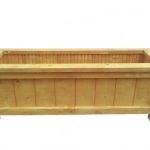We may receive a commission when you use our affiliate links. However, this does not impact our recommendations.

When making through-mortises by hand, one of the occasional problems is that you get a little mallet happy, you drive the mortise chisel a little too deep and you blow out a piece of grain on the exit side.
Or you drive a too-tight tenon into the through-mortise, the tenon hits the rim of the exit hole and the grain blows out. Or , when making angled through-mortises , your chisel lifts up the face grain when you are bashing out the acute side of the mortise. The results are anything but cute. Here’s how I repair the damage.
The most important step is to make the repair immediately. If you put off the fix, one of two bad things can happen.
1. You can lose the piece of loose grain.
2. The wound will collect dust, or the strings of torn grain will get knocked around. If either of these things happens, you’ll never get the piece back together.

The first step with this repair is to clean the wound. When mortising, you can drive some chips into the gash. Get a knife or a chisel and clean out the junk you might have forced into the split. Sometimes you have to make the split worse to do this. That’s OK.

Get your glue. I use yellow glue for most of these repairs. It’s fast-drying and strong. Cyanoacrylate is faster, but I have found that it’s also quite brittle. One good knock and the split will open again.
Pry open the wound a bit and wick the glue into the split. If possible, I’ll hold the workpiece so that gravity will help wick the glue in. If you can’t get the glue to wick into the split, pry the opening a little more. Or thin a little yellow glue with water. (This will also slow its drying time.)

Press the grain flat with your fingers and ensure that glue is squeezing out where it should , all around the split. Then tape the grain down. I use blue painter’s tape. Then put a clamp on the repair. Or use the pad of a holdfast if it’s a chair seat or some other large piece of work where your clamps won’t reach.

You can remove the clamp after an hour or so. I don’t recommend you work the split until the glue has reached its full strength, which usually takes a day.
– Christopher Schwarz
Here are some supplies and tools we find essential in our everyday work around the shop. We may receive a commission from sales referred by our links; however, we have carefully selected these products for their usefulness and quality.








sometimes in our shop, when things of this sort happen, we use 3M tape. its a stretchable, clear, resilliant tape, with high tear resistance. We call it v-fold tape, because that’s our main use for it. But in a repair like this we’d actually stick something on top of the repair (non-stick plastic) after gluing, then apply the tape with pressure, no clamp needed.
This tape works great for many clamping appliocations.
I commonly use it for glued mitres, seams, joints, and solid edgebanding for cabinetry.
Marshall – I hate to admit it, but you are not the only one who saw the clamp that way!
Russ
never mind i see that you rotated the stock…lol… man oh man i guess i am getting old…lol…thanks again
i noticed that you put the clamp on the sides, as if you where holding the tape down, instead of putting the clamp head directly on top of the "tape covered wound". do you do this for a specific reason? i have always clamped directly on top, and have never had a problem with the mend, no tape induced tear out….have i just been lucky? thank you
Chris,
sometimes if a clamp won’t reach or I am in a hurry I will hit the repair with the steam iron and cook the glue dry. Be careful not to scorch the surrounding area.
Mike
Thanks for this info as I plan to blow-out some mortises in the not-to-distant future. After reading this post I’m experiencing what I believe to be a deep level of satiation… I think I need to nap for a couple hours now. ;-]
-Charles
I like their nail clippers!
Honestly, they make and sell a great number of quality knives. I’m not a "knife guy" but I never leave home without one. I’ve bought many Russell knives over the years. And he’s a woodworker as well.
Chris
Chris,
It does look like a very interesting and useful knife. Are there any other products A.G. Russell carries that you might recommend?
Thanks,
Richard
Larry,
It’s the SK2 SuperKnife from A.G. Russell (in my home state!).
http://www.agrussell.com/superknife—silver/p/CEM-501/
It’s a great, great knife.
Chris
Excellent tutorial as always, Chris.
Not exactly on topic, but … what kind of utility knife is that you’re wielding there? That’s gotta be the most slender business end I’ve yet seen. I want one!